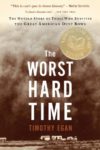Dusters are making news again (a rare one wreaked havoc in central Illinois this past week). According to the National Oceanic and Atmospheric Association, they are increasing in numbers. A dust déjà vu?
Mention the Dust Bowl and many of us think of the Joad family’s migrant escape to California in John Steinbeck’s classic, “The Grapes of Wrath.” Like the fictional Joad’s, millions of real people fled the Plains States during the Dirty Thirties. What was life like for those who stayed behind?
In “The Worst Hard Time: The Untold Story of Those Who Survived the Great American Dust Bowl,” author Timothy Egan shares the true and riveting stories of some who experienced the full fury of the storms.
The Black Blizzard of April 14, 1935 ripped an estimated 300 million tons of topsoil from the prairie states, but it’s a mistake to think of the Dust Bowl as a single massive freak storm, like a Hurricane. The man-made weather phenomena lasted almost a decade, producing more than 300 storms that could reduce visibility to zero and killed animals and people who choked on the black dust. 
My family weathered the Great Depression (no pun intended) with its associated hardships: scarcity of food, work, medicine to name a few. My mother read “The Worst Hard Time” and she agreed that for all the difficulties and challenges they endured, at least they weren’t assaulted by billowing walls of dust and suffocating dust pneumonia.
“The Worst Hard Time” is a lesson in history and the environment. It also offers a beautifully written homage to the resilient lives and legacies of those who endured that worst hard time.
